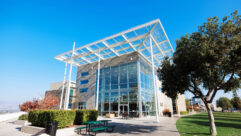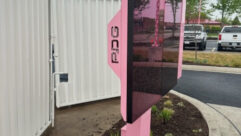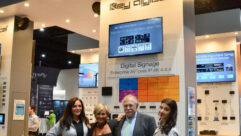LITE and Christie Digital Debut LONI Fiber-optic Network at Supercomputing 07
Nov 28, 2007 8:00 AM
Click here for more news on Cables from The Briefing Room
Visitors to the Supercomputing 07 conference in Reno, Nevada, Nov. 10-16, 2007, had the opportunity to experience firsthand the power of high-bandwidth, low-latency optical networks when they immersed themselves in live visual simulations ranging from hurricanes to house fires. Conference attendees explored these simulations from inside a large stereoscopic display located at the Reno Convention Center, while the actual computations and data were housed at a large supercomputing complex located 2000 miles away at the Louisiana Immersive Technologies Enterprise (LITE) in Lafayette, La.
This long-distance, virtual magic was made possible largely by the Louisiana Optical Network Initiative (LONI), a fiber-optic network that connects computers at Louisiana universities and research centers and links them to the National LambdaRail, the nation’s optical fiber backbone. A team of LITE researchers, University of Louisiana at Lafayette faculty and students, and technical experts from Christie Digital demonstrated groundbreaking LONI and Lambdarail applications that placed advanced interactive visualizations of complex phenomena right at the fingertips of researchers and industry practitioners, regardless of the physical location of the computation resources and data.
For the Supercomputing demonstrations, the LONI network helped connect a variety of simulations with the display located thousands of miles away. Each of these realtime interactive applications was displayed on a large-scale Christie TotalView 3D/Advanced Visualization solution. Featuring Christie’s window and processing system, the Vista Spyder, these incredible simulations and other content were displayed in both 2D and 3D modes simultaneously.
Steve Landry, vice president of academic affairs at the University of Louisiana and LONI’s chief technical advisor says, “Faculty researchers and students now have the means to address challenging research that demands flexible access to the most advanced technologies available. LITE and LONI, individually and even more so in combination, bring unparalleled resources to our university; enabling us to work on exciting projects in a wide range of disciplines that were previously not possible. It will also enable us to strengthen our academic programs and produce the next generation of graduates ready to strengthen our nation’s competitiveness in technology development and deployment.”
“Last year, LITE and LONI were still a concept; today they are both a reality. We have worked very intensively to make LITE one of the nation’s best places to enable innovative relationships among academic research, industry, and government organizations,” says Dr. Carolina Cruz-Neira, executive director of LITE. “LITE and LONI together provide a unique platform to experiment and deploy novel technologies that take advantage of high-end computing and networking crossing geographical barriers.”










